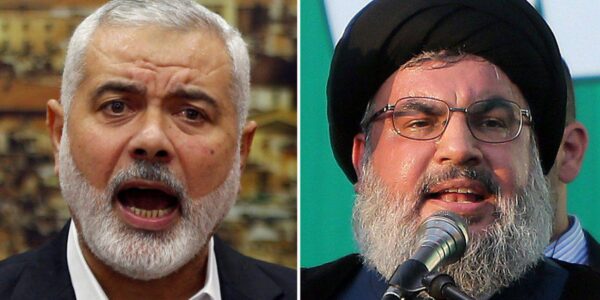
Hamas and Hezbollah terrorist groups seek global terror front against Israel
Hamas leader Ismael Haniyeh recently met Hezbollah leader Hassan Nasrallah in a widely expected meeting. It was designed to showcase that the two terrorist groups can meet openly as if they are governments of two countries.
Hamas is on a regional tour after receiving red-carpet treatment in Istanbul from Turkish President Recep Tayyip Erdogan. The US condemned that meeting. Hamas then went to Lebanon to hold court with Hezbollah, despite the recent horrific explosion that decimated Beirut. While rescuers were searching with dashed hopes for survivors, Haniyeh and Nasrallah were toasting success.
What is the element of that success? Hezbollah believes it is unchallenged in Lebanon. Despite French President Emmanuel Macron seeking to pressure Beirut to form a more technocratic government, it scored a win by having the leader of its parliamentary delegation meet Macron. The terrorist group doesn’t appear to fear that questions about the ammonium-nitrate explosion in August will implicate it in illegal weapons storage throughout the country.
Haniyeh met Nasrallah to discuss developments in Lebanon and the Palestinian areas, according to Fars News in Iran. There are large numbers of Palestinians in Lebanon who live in refugee camps that have become their own neighborhoods. These Palestinians have the same political groups as in the West Bank and elsewhere, and Hamas wants to gain inroads with them.
Hezbollah vows to “resist” Israel and puts photos of al-Aqsa Mosque on its propaganda, indicating how the groups are aligned. They are also aligned with Iran, which supports them both. Hamas also receives political support from Turkey, and its members operate there.
The meeting shows how these groups – both of them extralegal terrorist groups that traffic in weapons – are eroding state institutions, since they meet without the Palestinian Authority or Lebanese officials present.
The leaders complained about US President Donald Trump’s “Deal of the Century” and said they wanted the “Muslim ummah” to oppose Israel, Fars News reported. They claimed their “axis of resistance” was stable and talked about how strong their relationship is, emphasizing “brotherhood and Jihad.” They want to form a “regional alliance” against the US and “Zionists,” according to the report.
It is Haniyeh’s first known visit to Lebanon since 2003. According to other statements by Hamas reported by Fars News, it appears the organization now realizes it needs strategic partners to confront Israel and that these partners are in Lebanon and Istanbul. This is about creating a counter to what Haniyeh says is a “strategic threat to Palestinian aspirations.”
The recent UAE-Israel deal and Israeli successes in blunting Hamas threats have led Hamas to this conclusion. It tried military means to destroy Israel in the past, including bus bombings and tunnels, but it has largely been isolated over the last 15 years.
Hezbollah also fought a war with Israel in 2006. But since then, it has focused on stockpiling weapons, including drones and precision-guided munitions. Despite tensions with Israel last August and this July over the killing of its members in Syria, a conflict has not developed.
Hezbollah is trying to swallow and digest the Lebanese government, going from being a state within a state to controlling many levers of power. This has been a long path – including the 2008 clashes, putting Michael Aoun in the presidency and intervening in Syria.
In some ways, Hezbollah and Hamas are maturing. Nasrallah was born in 1960 and Haniyeh in 1962. Their formative experiences were in the 1980s, when Hezbollah was rising in Lebanon and fighting Israel and when Hamas was beginning to grow its tentacles in Gaza and the West Bank. They both were becoming full-fledged adult terrorists when Israel appeared to be giving up territory in the West Bank after the Oslo Accords and when it left Lebanon in 2000.
With advice from Iran, Hezbollah challenged Israel after 2000. Hamas thought it could come to power through elections, while using terrorism at the same time. Both movements have had to govern over the last decade because they have grown in power.
But with power comes responsibility. Neither want the responsibility of being held to account as a state, but both appear to want to function like a state. Like Iran using the term “revolution” for an ossifying regime that is opposed by its people, these groups talk about “resistance,” when in reality it is the young generation that wants to be free of their 1980s mentality and shackles of sectarianism.
The meeting in Beirut was an attempt to prove some kind of relevance and legitimacy. Whether they can leverage support from Iran, which is starved for cash by US sanctions, remains to be seen.
Source: JP





